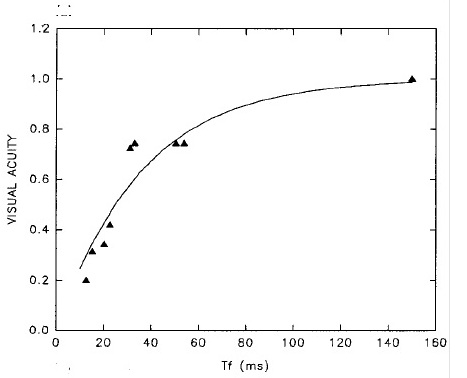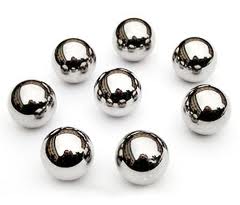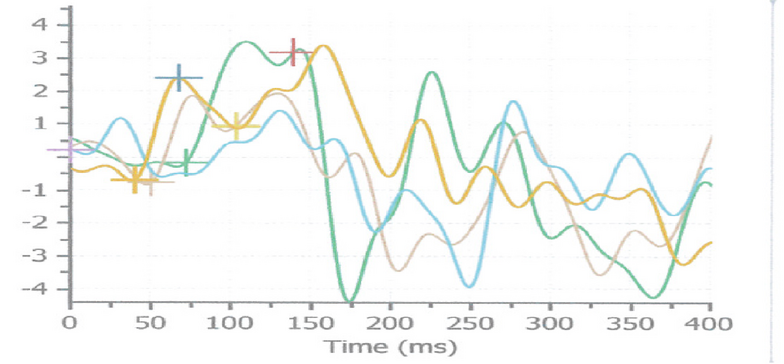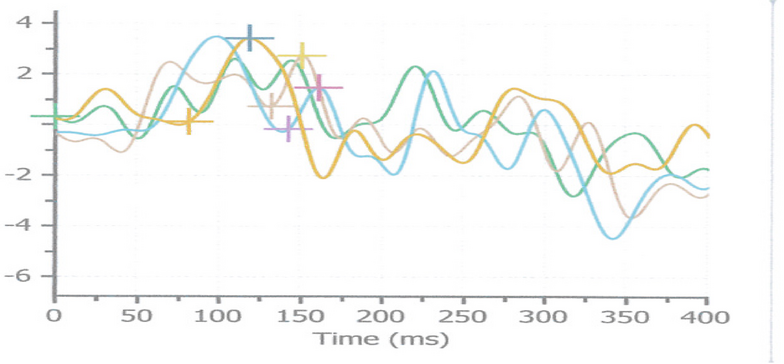The Physiology of Foveation- How ProFoveate™ improves your vision!
Dell' Osso has shown that in order for a person to see an object clearly, the eye must remain fixed on the target for about 30 milliseconds. Indeed, Dell' Osso and others have shown that the visual acuity of the individual depends critically upon the foveation time.
30 milliseconds. Seems like such a short time. And it is, unless you have Nystagmus. To get an idea of how long that is and what an impact foveation time has on your visual acuity, look at the graphic below. It graphs visual acuity as a function of foveation time.
If you have perfect vision, then your vision is expressed as the fraction 20/20 which equals 1 and your visual acuity is 1.0. If you have vision of 20/100, then your visual accuity is 0.2. With a visual acuity of 0.2, your foveation time is about 10 milliseconds.
Visual acuity before ProFoveate™ was 20/80 or 0.25 which corresponded to a foveation time of about 10 milliseconds.
But with the ProFoveate™ spheres in place, visual acuity improved to 20/25 or 0.8. That corresponds to a foveation time that is almost 60 milliseconds, almost 6 times the initial value.
This explains the relationship between foveation time and visual acuity gains that ProFoveate™ users can achieve. If you can extend the foveation time, just a few milliseconds, the growth in the visual acuity is enormous.
Graphic from Sheth et al. Your gain need not be as large as that shown in the patient inset graphic shown here to see dramatic results. Suppose your vision is 20/100, if you could add 20 milliseconds to your foveation time, your vision would be 20/40, GOOD ENOUGH TO DRIVE!
Sheth NV, Dell'Osso LF, Leigh RJ, Van Doren CL, Peckham HP, The effects of afferent stimulation on congenital nystagmus foveation periods. Vision Res. 1995 Aug;35(16):2371-82.
ProFoveate™. A Breakthrough in Foveation!
A Final Word on the Validity of the Scientific Basis of ProFoveate™
"Now that the tenotomy procedure has demonstrated
the power of using proprioceptive muscle tension control to
to damp nystagmus, other methods should be explored
to alter the firing rate of the proprioceptive sensors
in the extraocular muscle tendons. The approaches
to altering the functions of the distal tendons might
include: mechanical, merely suturing or otherwise mechanically
changing them without actual tenotomy;
cryogenic, heat or cold application; or pharmaceutical,
microinjection. Thus, mechanical, cryogenic or pharmaceutical
tenotomy might preclude the need for surgical
tenotomy. Clearly more research into the proprioceptive
tension control system and methods to alter it
are needed to both better understand its function and
use that knowledge therapeutically."
Z. I. Wang and L. F. Dell'Osso, A Review of the Tenotomy Nystagmus Surgery: Origin, Mechanism, and General Efficacy, Neuro-Ophthalmology, 2007, Vol. 31, No. 5-6 : Pages 157-165
ProFoveate™ uses the principle of altering the proprioception as outlined above in the concluding statement of Wang and Dell' Osso, but, without sutures, without heat, without cold, and without pharmaceuticals to help you or your loved one achieve lasting foveation that actually improves your visual acuity. Tenotomy does not always bring increased visual acuity even though foveation times are increased by as much as 100% and head position rotations for best sight is reduced significantly. Here is a possible reason.
Seeing is like playing darts. In the game of darts, to hit the target, you hold yourself stationary and the target is stationary. But what if the target was moving? Then you have to throw so that the target will be in the right spot when the dart strikes the wall. This is a much harder task. With Nystagmus, the target is the fovea in the back of the eye. The dart is the image of an object in front of the eye. Unless the eye can be held still, the image coming toward the fovea of the object will miss the fovea because the eye has moved. When your eyes move, the image is not held on the fovea long enough to make sense of what is being seen.. That is like mising the bull's eye. Tenotomy causes the image to land closer to the fovea than before, but, the image keeps landing on one side or the other of the fovea Only dramatic reduction in the frequency of the signal that is sent to the eyes to move can take tenotomy, the procedure Prof. Dell'Osso pioneeered decades ago, to the next level. The ProFoveate™ method goes beyond damping of eye movement amplitude. ProFoveate™ dramatically reduces or eliminates the frequency with which the eye moves. So everyone who has Nystagmus can benefit from ProFoveate™ without regard to surgical status.
ProFoveate™ is the future of tenotomy that your grand-son or grand-daughter has been awaiting. Give your son or daughter a better future for a little more than the cost of a purchase of a specialty coffee and pastry at your favorite coffee shop everyday.
If it is for you, why wait?
No more waiting.-------John Gentry, BS,MS,DABR, Clinical Medical Physicist
Direct Evidence Based on Mapping of Visually Evoke Potentials in the Brain.
The Diopsys Neuro Optic Vision Assessment (NOVA) (VEP) measurements of the neurological elements of the entire vision system are designed to determine the size of the neurological messages that reach the brain from the eyes. The brain response to visual stimuli was assessed in a nystagmatic patient with and without the use of the ProFoveate materials and techniques. Increases in visual acuity and foveation experienced by the user coincide with increases in the size (positive and negative) of the neurological signals reaching the visual center of the brain.
Without ProFoveate.
With ProFoveate.
To those unfamiliar with the information that may be gleaned from the above EEG diagrams, the Y-axis is the electrical activity associated with the brain and is measured in microvolts. The X-axis is the time in milliseconds that is necessary for the eye to see and begin to track a moving object.
Beyond the change in the size of the stimulus that the brain receives as a result of the use of ProFoveate, the eye/brain combination is responding faster to random external visual stimuli.
Note the position change of the BLUE CROSS in the two views. Without ProFoveate, it can be seen that the Blue CROSS is positioned between 100 ms and 125 ms meaning that this is the time necessary for the eye to see and react to the stimulus.
With ProFoveate, note the new position of the BLUE CROSS. It has moved to the left. The eye responded to the same stimulus, placed randomly among other stimuli, with a speed of 50 ms to 75 ms.
Available through your doctor's prescription, get ProFoveate™ and get on wth life! Schedule an appointment at info@profoveate.com today!
Available through your doctor's prescription, get ProFoveate™ and get on wth life! Schedule an appointment at Summit Eye Associates of Gastonia, NC if you live close! 704-865-3937




